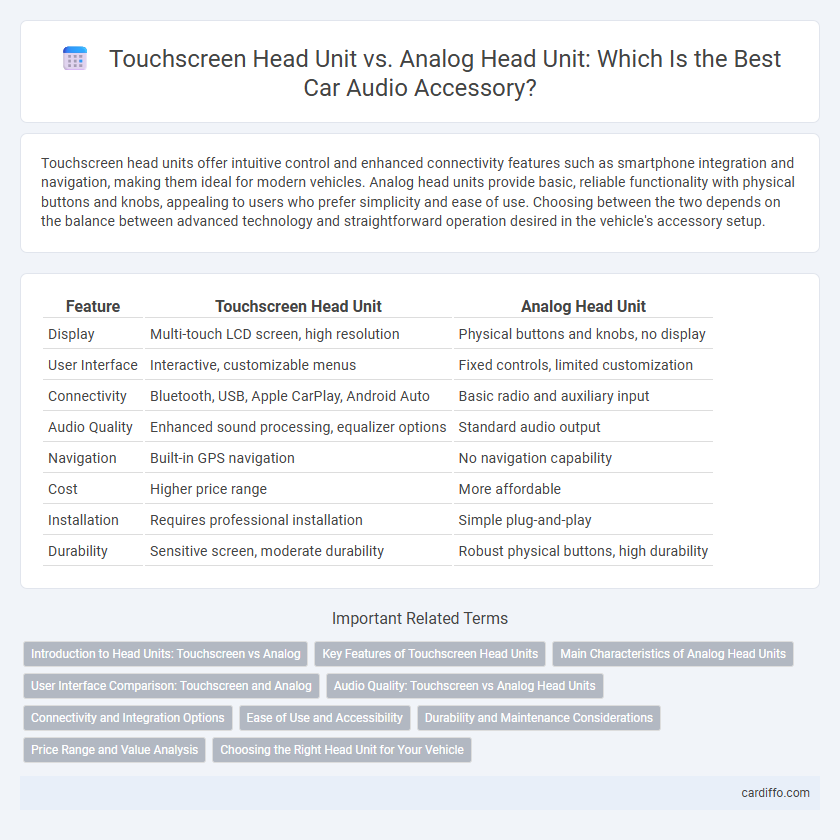Touchscreen head units offer intuitive control and enhanced connectivity features such as smartphone integration and navigation, making them ideal for modern vehicles. Analog head units provide basic, reliable functionality with physical buttons and knobs, appealing to users who prefer simplicity and ease of use. Choosing between the two depends on the balance between advanced technology and straightforward operation desired in the vehicle's accessory setup.
Table of Comparison
| Feature | Touchscreen Head Unit | Analog Head Unit |
|---|---|---|
| Display | Multi-touch LCD screen, high resolution | Physical buttons and knobs, no display |
| User Interface | Interactive, customizable menus | Fixed controls, limited customization |
| Connectivity | Bluetooth, USB, Apple CarPlay, Android Auto | Basic radio and auxiliary input |
| Audio Quality | Enhanced sound processing, equalizer options | Standard audio output |
| Navigation | Built-in GPS navigation | No navigation capability |
| Cost | Higher price range | More affordable |
| Installation | Requires professional installation | Simple plug-and-play |
| Durability | Sensitive screen, moderate durability | Robust physical buttons, high durability |
Introduction to Head Units: Touchscreen vs Analog
Touchscreen head units offer an intuitive interface with customizable displays, supporting advanced features like GPS navigation, smartphone integration, and multimedia playback. Analog head units provide straightforward controls with physical buttons and knobs, ensuring durability and ease of use without digital distractions. Modern vehicles increasingly favor touchscreen head units for enhanced connectivity, while analog units remain popular in budget and classic car models.
Key Features of Touchscreen Head Units
Touchscreen head units offer advanced multimedia integration with large, responsive displays that support smartphone connectivity through Apple CarPlay and Android Auto. These units provide intuitive, customizable interfaces and enhanced vehicle control features such as GPS navigation, voice commands, and Bluetooth hands-free calling. Their digital capabilities significantly improve user experience compared to traditional analog head units that lack interactive and smart functions.
Main Characteristics of Analog Head Units
Analog head units primarily use physical buttons and knobs for control, offering tactile feedback and simplicity in operation. They rely on traditional radio frequency signals and wired connections, without touchscreen interfaces or integrated digital features. These units are often preferred for their straightforward functionality, durability, and ease of repair.
User Interface Comparison: Touchscreen and Analog
Touchscreen head units offer an intuitive user interface with dynamic visual menus, allowing quick access to navigation, media, and vehicle settings through a responsive display. Analog head units rely on physical buttons and knobs, providing tactile feedback but limited customization and slower operation. Touchscreen interfaces enhance user experience by integrating smartphone connectivity and voice controls, whereas analog units prioritize simplicity and durability.
Audio Quality: Touchscreen vs Analog Head Units
Touchscreen head units typically deliver superior audio quality due to advanced digital signal processing and customizable equalizer settings, enhancing sound clarity and depth. Analog head units rely on traditional circuitry, which may result in lower fidelity and limited audio customization options. Users seeking crisp, dynamic sound often prefer touchscreen units for their enhanced audio performance and versatility.
Connectivity and Integration Options
Touchscreen head units offer advanced connectivity options such as Bluetooth, Wi-Fi, and smartphone integration through Apple CarPlay and Android Auto, allowing seamless access to apps, navigation, and voice control. Analog head units primarily rely on basic inputs like AUX and USB ports, limiting connectivity to direct wired connections without smart device synchronization. Integration with vehicle systems is more sophisticated in touchscreen units, supporting backup cameras, steering wheel controls, and real-time data display, which analog units typically lack.
Ease of Use and Accessibility
Touchscreen head units offer intuitive navigation through large, responsive displays that enable quick access to multimedia and vehicle settings, significantly enhancing ease of use. Analog head units rely on physical buttons and knobs, which can be less efficient but provide tactile feedback beneficial in low-visibility situations. Accessibility is improved in touchscreen units with customizable interfaces and voice control integration, while analog systems maintain simplicity with straightforward controls preferred by some users.
Durability and Maintenance Considerations
Touchscreen head units often feature sealed glass screens and fewer mechanical parts, enhancing durability by resisting dust and moisture compared to analog head units with physical buttons and knobs prone to wear and tear. Maintenance for touchscreen units typically involves software updates and screen calibration, while analog units may require physical repairs or replacements of buttons and switches. Choosing between the two depends on the balance between modern interface benefits and the straightforward, often easier repairability of analog components.
Price Range and Value Analysis
Touchscreen head units typically range from $150 to $600, offering advanced features like GPS navigation, smartphone integration, and customizable interfaces that justify their higher price. Analog head units are generally priced between $50 and $150, providing basic radio and CD playback without smart functionalities, making them more affordable but less versatile. The value analysis favors touchscreen units for users seeking enhanced connectivity and multimedia options, while analog units suit buyers prioritizing budget and simplicity.
Choosing the Right Head Unit for Your Vehicle
Choosing the right head unit for your vehicle involves evaluating the features and user experience of touchscreen head units versus analog head units. Touchscreen head units offer advanced connectivity options such as Bluetooth, GPS navigation, and smartphone integration, enhancing convenience and multimedia control. Analog head units provide simplicity, reliability, and ease of use, making them ideal for drivers seeking straightforward functionality without digital distractions.
Touchscreen Head Unit vs Analog Head Unit Infographic

 cardiffo.com
cardiffo.com